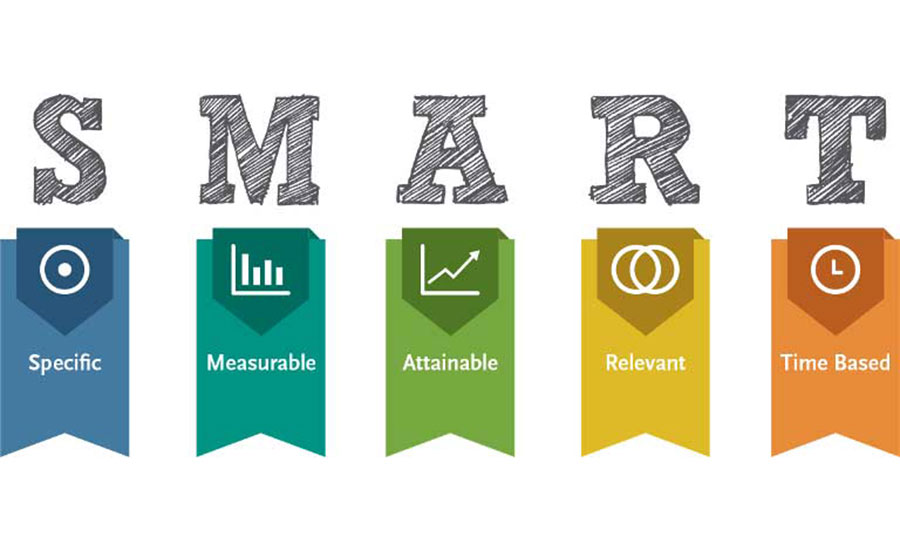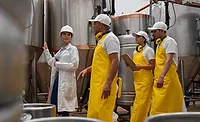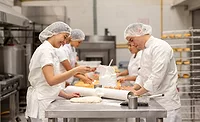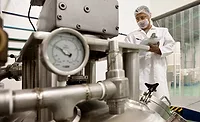Tips to Overcome Supply Chain Challenges for Food Manufacturers
Many facilities have moved from "just in time" to "just in case" inventory management, which translates into a need for additional storage capacity

Image credit: simonkr/E+ via Getty Images
Supply chain constraints are not a new challenge in the food industry. Even before the COVID-19 pandemic created additional hardships, the food industry has always had to deal with difficulties in the supply chain. Food is a global market, and even the smallest food processor brings in food ingredients, packaging, and equipment from around the world. The food industry is not immune to environmental disasters or political unrest in the global environment. Since the food supply chain is very complex with multiple stakeholders, processors, brokers, and transportation involved, it is susceptible to turbulence and instability.
In lean manufacturing or Six Sigma or operational excellence—whatever nomenclature you choose to use—there is an inventory concept known as "just in time." Inventory costs money. It must be stored and moved around, and it requires infrastructure. The more it is touched, the more motion and transport are wasted, and the more opportunities arise for damage and loss. Food companies have traditionally worked with their suppliers and their sales forecasting teams to create processes enabling products and ingredients to be ordered for arrival just as they were needed on the manufacturing floor. This translates into less waste and more efficiency. However, this methodology only works when a good understanding of sales and forecasting is available, and when lead times from suppliers can be trusted.
Recently, I was working with a food manufacturer that was expanding its facility. I was talking with the various subcontractors about the necessary electrical, plumbing, HVAC, concrete, etc., trying to project manage. However, we could not get any of the subcontractors to commit to a time when they would be ready to install. Their equipment suppliers were giving them lead times of two to three months, although we knew that we could not rely on that data because it would likely be much longer. It is very difficult to plan a project when no one knows when the equipment will be onsite to be placed, wired, plumbed, etc.
Anecdotally, however, I hear that things are slowly starting to get back to normal. No one really knows what the "new normal" will actually look like. These challenges are likely here to stay for a while longer, and so the food industry needs to be adaptable. Some would argue the industry is highly adaptable, while others would point to prior experiences with previous companies as examples of why the food industry can be inflexible. However, we must roll with the punches and figure out new strategies and new programs to be able to stay in business.
Single-Source Suppliers
As an industry, we have struggled with single-source suppliers—whether it is a piece of equipment that is made by only one company and you are at their mercy for spare parts, or a consumer flavor profile that requires an ingredient grown in only one area of the world. The COVID-19 pandemic amplified the issue with global transport and workforce shortages. Ports were closed or slowed to a crawl; factories were shut and their workforces out due to illnesses or governmental mandates. With these issues in mind, we must look within our networks and communities for potential solutions to the challenges posed by single-source suppliers.
If an equipment issue is at play, see if any local machine shops can use CNC machines or 3D printing to make spare parts or repair a piece of equipment. Get in touch with local trade schools, technical high schools, or community colleges. Many of these institutions have programs for future engineers, maintenance, and automation technicians. Career technical education has been a fixture of the U.S. academic system since before the federal Smith-Hughes National Vocational Education Act of 1917. Many instructors and program managers enjoy working with local industry to give hands-on practice to students. These students are your future workforce, so what better way to prepare them than to work with them while they are still in school?
Regarding ingredients, a food manufacturer must ask itself critically: "What are the wants and needs of my customer?" A company's quality personnel understand the necessary activities to reach the voice of the customer and the attributes that are critical to quality. It is important to ensure that your market research and sensory panels are robust. Can you meet the functionality, stability, taste, texture, visual appearance, marketing claims, etc. with another ingredient, or can that ingredient be eliminated? Critically look at your formulation. Do you really need that ingredient? Can another ingredient be substituted if necessary? Investigate additional suppliers or brokers. Although the food industry is typically highly competitive and does not necessarily encourage disclosures with other companies, could you contact any other companies that use that ingredient to ask about their suppliers or the possibility of purchasing excess supply? The latter method worked for a couple of local companies—a smaller company needed an ingredient that it was not able to source through its regular channels, and I contacted another company in the area that used the same ingredient, and was able to make a connection. In this case, teamwork and collaboration paid off.
Looking for quick answers on food safety topics?
Try Ask FSM, our new smart AI search tool.
Ask FSM →
Warehousing
Many facilities have moved from "just in time" to "just in case" inventory management, which translates into a need for additional storage capacity. However, warehouses that specialize in food and beverage product storage are in short supply and tight on space. Although your product may be sealed and closed during warehousing, there are still many potential food safety concerns. For example, if your product is stored next to, above, or below a non-food product, it could pose a hazard. I had a client that was using an alternative storage location and did not know that the warehouse also stored automotive materials. The materials gave off a strong odor that infiltrated the product packaging, causing it to smell and taste like oil. The entire product stored at the facility had to be destroyed, as there is no way to remove that smell or flavor profile from a product.
Additionally, there is always a potential for allergen cross-contact in warehousing. I have worked with warehouses that are trying to add food and beverage clientele to their portfolio and, many times, they do not understand the requirements to store food. It is not like your home pantry or “junk drawer.” If a facility is not familiar with handling food products, then it may not have a robust cleaning and sanitation program or an adequate pest control program. It may not understand food defense or intentional adulteration and the requirements to keep a facility secure against potential nefarious actors. If your product must be stored at a certain temperature (refrigerated or frozen) and if a facility does not have the proper controls and measurements, then your product could undergo temperature abuse, causing food safety and/or quality issues. One freezer is not the same as another. Ensuring that defrost and condensate are managed appropriately, and ensuring that the unit has the appropriate temperature monitoring and alarm systems are important for ensuring the food safety and quality of your product. Consequently, you must work more closely with these alternative warehousing providers. This means additional visits and more extensive explanations of your requirements and how your product's safety and quality could be impacted. All are needed to ensure that your product is kept safe during storage.
One possibility is to look for alternative solutions to existing warehouse space. Speak to your local economic development groups and realtors. Are there any existing buildings that are not being utilized? If a local business has closed and the space is currently not being used, can it be retrofitted into a short-term storage solution? Is there any business incubator space that is not being used? One of my colleagues was able to utilize a closed department store as a warehousing solution. It already had loading docks that semi-trailer trucks could access. In addition, the facility had employee amenities (restrooms, breakrooms, etc.), the lighting was excellent, and pest control was in place (although the frequency had to be increased). The company had to put in a wall to eliminate public access. The building did not have racks, so floor stacking was the only option. The company put some tape on the floor to mark storage locations for inventory management. In addition to a few other minor modifications at relatively low cost, the company was able to utilize 125,000 square feet for storage.
Distribution
Whether shipping by rail or truck, finding vehicles and vessels that comply with the sanitary transport rule can be difficult. I remember a time, years ago, when refrigerated trailers that had just hauled Christmas trees would pull in to pick up product. Not many people want evergreen-flavored cheese. In my geographic area, like many of yours as well, we ship out more product then we bring in. We are located several thousand miles from the nearest port, and so trucks and trailers would have to dead-head into the area to pick up product, which means that they were running their trucks and consuming diesel with no product to justify the expense. No one wants to put miles on the truck without carrying a product to justify the cost.
Ensure that you have contacts with a few different brokers so you can have access to as many options as possible. In addition, investigate if you have any local companies that offer transportation services that you might be able to utilize. Furthermore, ask other food processors in the area about their preferred vendors and which ones they have been able to use successfully.
Risk-Based Supply Chain Programs
It is always better to have multiple suppliers or vendors, if possible; however, redundancy is not always achievable. Regardless of whether you have one supplier or multiple suppliers, it is imperative that your supply chain program is strong and fully functioning. Everything is a risk; you need to ensure that your risk management strategies are robust. Do you have a high-risk ingredient, or is a supplier a high-risk company? What practices and protocols can you put in place to reduce the risk to an acceptable level? Within your supply chain, you need to have categories of risk that clearly define what is a high or low risk (color or labeling schemes both work for this purpose). Lean on your food safety team and plan. Establish definitions of your risk categories. Ensure that you are researching supplier facilities and the ingredient's inherent risks to your product:
- Review recalls for both the supplier and the product, along with similar products.
- Research if the supplier has any warning letters or adverse regulatory findings.
- Both the U.S. Department of Agriculture (USDA) and the U.S. Food and Drug Administration (FDA) offer hazard table documents. Use these to discern the risks listed for the ingredient, processing aid, or packaging.
- Find out if the supplier complies with Foreign Supplier Verification Program (FSVP) requirements.
- Review the supplier's specifications and food safety plans, along with the risks it lists in its process and ingredients. Discern if the supplier's intended use and consumers match your product expectations.
- Do not discount your previous relationship with the supplier and your history of use of the ingredient.
After you have determined the risk, you must then determine what strategies you can employ to reduce the risk, as detailed below.
Documentation
Many food facilities require a list of documents from their suppliers as part of their supplier qualification program. Is someone qualified reviewing those documents? It is one thing to have a document on file, but if someone qualified is not reviewing the documentation, then the risk is not being managed. A person who understands your programs and risks must review the documentation. For example, one of my clients was using an ingredient in the research and development process and was ready to ramp up to full production. The purchasing staff had collected the documentation, but no one who understood allergen cross-contact and the associated food safety implications had fully reviewed the ingredient, which had egg in it. The food manufacturer did not have any other products with egg and had not updated its sanitation program, labels, or allergen control program for the new allergen. A quick call to the manufacturer helped clarify the situation, and the company was able to reformulate without the egg. However, it took someone with an understanding of food safety risks to review and discover the complexity.
Do you have current documentation? Sophisticated systems are available to help organize documentation. Advertisements for those companies can be found in many publications, including this one, and are available at trade shows. However, I have talked with many suppliers that use a simple spreadsheet to organize and record dates of documentation. A quick glance at the spreadsheet shows when elements have expired. You do not necessarily need to have state-of-the-art software to keep your supplier approval documentation organized and relevant; however, you must have a system or process to ensure that documentation is updated and current.
Testing—Certificate of Analysis (COA)
You cannot test your way out of a problem. Ensure that you understand the testing frequency and methodologies associated with testing on the COA. Is the test result reflective of each individual lot, or is a sample tested only once a year and then placed on the COA for the entire year? Ensure that the sampling plan and frequency are adequately designed to actually detect an abnormality or contaminant.
Auditing
Audit the facility yourself, and be on the lookout for any of these potential issues. I know that Global Food Safety Initiative (GFSI)-approved auditing schemes were supposed to eliminate many of these customer audits, but as a food manufacturer, your product will be the one impacted if there is a recall because of an ingredient issue or a storage and warehousing program.
It is preferable to visit current and prospective suppliers in person. If you cannot visit because of geography, budget, employee knowledge base, or workforce shortages, then require the supplier facility to undergo a reputable third-party audit. During your supplier qualification, ask to see the entire audit, not just the certificate. What did the auditor note? What were the supplier's non-conformances? Have the practices improved? Another option to an in-person visit is a virtual tour. Although you will not be able to use all of your senses (except taste—please never lick the equipment), you will still be able to see the facility, the general structure and layout, the infrastructure, the sanitation and pest control programs, etc.
Vendor Relationship
It is important to have a working relationship with your vendors and suppliers. Frequent communication with your contacts at these companies is critical. If you have a great working relationship with your vendors, ingredient suppliers, and transportation and warehouse providers, they may have alternative solutions or be able to help with issues when they arise. In addition, they will be more willing to communicate when they are having issues, which will enable you to put in stopgap measures so that your production and quality are not impacted.
Small Businesses
What happens if you are a small business and you do not purchase ingredients directly from a manufacturer or broker, but rather from a local grocer or restaurant supply company? Since you are not a customer of the actual supplier, it may be difficult to get information from them, and so you must work with the grocer or supply company. Can you get copies of the grocer or supply company's requirements that manufacturers must follow in order to use shelf space in their facility as part of their supplier approval program?
Strategies (Notable Quotes)
"The secret of getting ahead is getting started. The secret of getting started is breaking your complex, overwhelming tasks into small, manageable tasks, and then starting on the first one." Some ascribe this quote to Mark Twain and some to Agatha Christie; however, whoever expressed the sentiment did so appropriately. One must start somewhere. Critically analyze where your largest gains are and work from there.
Another motivational quote is ascribed to Jonathan Kozol: "Pick battles big enough to matter, but small enough to win." You cannot solve all of the world's problems, but you can improve your own programs. Critically analyze your situation and look for solutions. Make sure to use the SMART acronym when planning your goals—Specific, Measurable, Attainable, Relevant, and Time-Based (Figure 1).

Summary
You cannot stay in firefighting mode forever. Ensure that your programs are resilient and flexible to manage our "new normal." Strategically analyze your bottlenecks and ensure that your risk management strategies are appropriate. Make contacts within your local schools, machine shops, economic development agencies, and fellow food manufacturers to enable teamwork and camaraderie. Good luck—you will survive!
Janna Hamlett, Ph.D., is an Assistant Professor at the University of Idaho Extension and a Food Processing Specialist with TechHelp, Idaho's Manufacturing Extension Partnership Center. She has over 15 years of experience in the food manufacturing industry, with a background in quality and operations management including numerous certifications in lean processing management, personnel safety, and food safety and quality programs.









